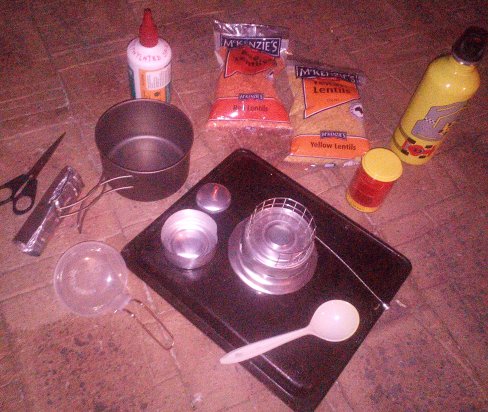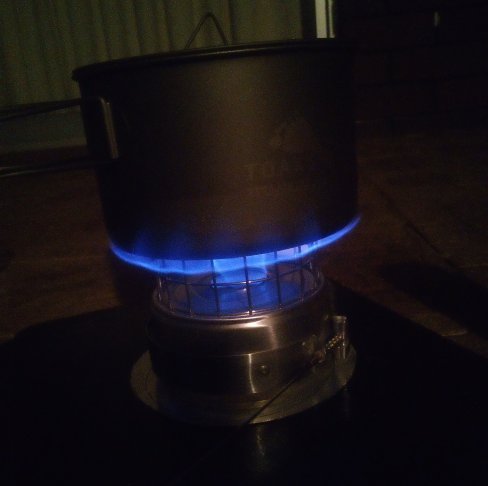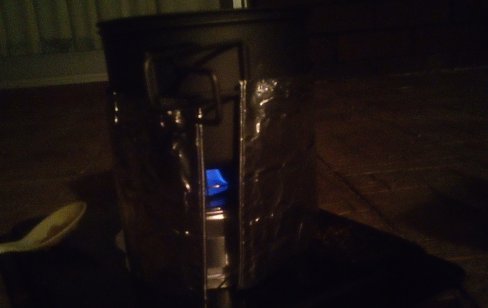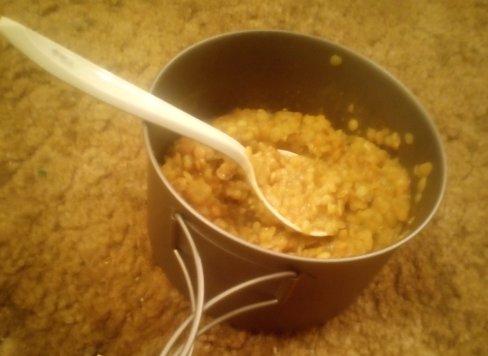Packafeather XL stove
June 14, 2016 —
BarryK
Today my eagerly-awaited Packafeather XL alcohol stove arrived.
The outstanding feature of this stove, apart from very light weight, is the cable control of the flame, enabling turning down the heat to simmer the food as required.
The first thing apparent upon opening the box, is that this is indeed the product of a "cottage industry". It is built from used aluminium containers, shows it, with some minor dents -- but, I must emphasize, that in no way detracts from its performance.
This time, I decided to cook lentils. I purchased red lentils and yellow lentils. Hmmm, this is where my very limited cooking experience shows -- I did not know that the yellow lentils need considerably longer to cook than the red lentils.
I also bought Clive Of India hot curry powder. That's it, total ingredients.
Here is everything ready to go:

You can see the XL stove in the middle. Right beside it is its fuel holder. The stove is simply placed on top of the fuel-holder. Just pour methylated spirits in to holder, put the main body of the stove on top. Light it before or after.
The circular disk is just a piece of aluminium from a baking tray (actually, a set of them, only a few dollars) that I bought at Coles. I also cut the windshield from the tray. The manufacturer recommends the disk for extra insulation from the ground. Here is the fuel-holder sitting on the disk:

No priming, it is ready to use immediately. Right off, the flame did look a bit yellow:

However, as soon as I placed the pot on top, it transformed into a beautiful blue:

Oh yeah, the recipe. My scoop holds about 70ml. One level scoop red lentils, one of yellow lentils, five scoops water, half of curry powder.
It came to a boil quickly, and I turned down the flame. Now, the important thing to understand here is that the flame does not decrease immediately. Wait awhile.
A method that seemed OK was to wind the cable clockwise until completely closed (minimum air getting in through the nozzles) then back off a turn or two. This does take practice, because I did extinguish the flame once, when I had the nozzles nearly closed.
The main point though, is that simmering really does work. Though, with my very thin titanium pot, the small concentrated flame in the centre of the pot did result in a patch of burnt food right in the centre. I am not sure how to deal with that, other than stirring the food.
Here is the flame set very low, with my baking-tray wind shield:

On the low flame, I wandered off, and checked back periodically to see how it was going. The yellow lentils took awhile, but eventually it was all mush, and I ate it -- simple recipe, but it tasted good.
Here it is:

Conclusion: it is a great stove, for when you want to actually cook food instead of just boil it.
I think next, I will try brown lentils. They are healthier than red lentils, as they have the skin still on them, but require a lot more cooking. Normally, I would pre-soak them, but I'm going to give it a go not doing that -- see if I can just leave it simmering long enough.
Manufacturer's website:
http://packafeather.com/xlstove.html
My earlier post about alcohol stoves:
http://bkhome.org/news/201606/alcohol-stoves-for-camping.html
Tags: light
